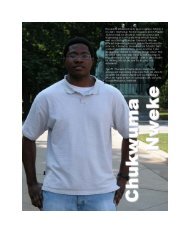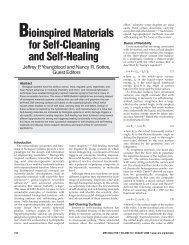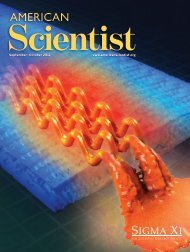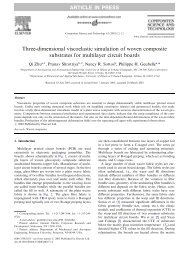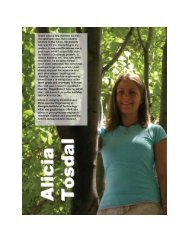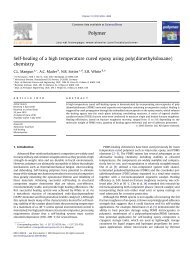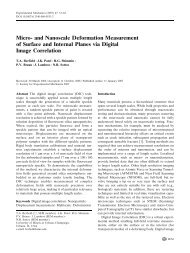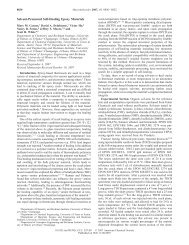Effect of microcapsule size on the performance of self-healing ...
Effect of microcapsule size on the performance of self-healing ...
Effect of microcapsule size on the performance of self-healing ...
Create successful ePaper yourself
Turn your PDF publications into a flip-book with our unique Google optimized e-Paper software.
Polymer 48 (2007) 3520e3529<br />
www.elsevier.com/locate/polymer<br />
<str<strong>on</strong>g>Effect</str<strong>on</strong>g> <str<strong>on</strong>g>of</str<strong>on</strong>g> <str<strong>on</strong>g>microcapsule</str<strong>on</strong>g> <str<strong>on</strong>g>size</str<strong>on</strong>g> <strong>on</strong> <strong>the</strong> <strong>performance</strong> <str<strong>on</strong>g>of</str<strong>on</strong>g> <strong>self</strong>-<strong>healing</strong> polymers<br />
Joseph D. Rule a,1 , Nancy R. Sottos b , Scott R. White a, *<br />
a Department <str<strong>on</strong>g>of</str<strong>on</strong>g> Aerospace Engineering and Beckman Institute, University <str<strong>on</strong>g>of</str<strong>on</strong>g> Illinois,<br />
405 North Ma<strong>the</strong>ws Avenue, Urbana, IL 61801, United States<br />
b Department <str<strong>on</strong>g>of</str<strong>on</strong>g> Materials Science and Engineering and Beckman Institute, University <str<strong>on</strong>g>of</str<strong>on</strong>g> Illinois,<br />
405 North Ma<strong>the</strong>ws Avenue, Urbana, IL 61801, United States<br />
Received 1 November 2006; received in revised form 29 March 2007; accepted 1 April 2007<br />
Available <strong>on</strong>line 12 April 2007<br />
Abstract<br />
The influence <str<strong>on</strong>g>of</str<strong>on</strong>g> <str<strong>on</strong>g>microcapsule</str<strong>on</strong>g> diameter and crack <str<strong>on</strong>g>size</str<strong>on</strong>g> <strong>on</strong> <strong>the</strong> <strong>performance</strong> <str<strong>on</strong>g>of</str<strong>on</strong>g> <strong>self</strong>-<strong>healing</strong> materials is investigated. These epoxy-based materials<br />
c<strong>on</strong>tain embedded Grubbs’ catalyst particles and microencapsulated dicyclopentadiene (DCPD). Aut<strong>on</strong>omic repair is triggered by rupture<br />
<str<strong>on</strong>g>of</str<strong>on</strong>g> <strong>the</strong> <str<strong>on</strong>g>microcapsule</str<strong>on</strong>g>s in resp<strong>on</strong>se to damage, followed by release <str<strong>on</strong>g>of</str<strong>on</strong>g> DCPD into <strong>the</strong> crack plane where it mixes with <strong>the</strong> catalyst and polymerizes.<br />
The amount <str<strong>on</strong>g>of</str<strong>on</strong>g> liquid that <str<strong>on</strong>g>microcapsule</str<strong>on</strong>g>s deliver to a crack face is shown to scale linearly with <str<strong>on</strong>g>microcapsule</str<strong>on</strong>g> diameter for a given weight fracti<strong>on</strong><br />
<str<strong>on</strong>g>of</str<strong>on</strong>g> capsules. In additi<strong>on</strong>, <strong>self</strong>-<strong>healing</strong> <strong>performance</strong> reaches maximum levels <strong>on</strong>ly when sufficient <strong>healing</strong> agent is available to entirely fill <strong>the</strong><br />
crack. Based <strong>on</strong> <strong>the</strong>se relati<strong>on</strong>ships, <strong>the</strong> <str<strong>on</strong>g>size</str<strong>on</strong>g> and weight fracti<strong>on</strong> <str<strong>on</strong>g>of</str<strong>on</strong>g> <str<strong>on</strong>g>microcapsule</str<strong>on</strong>g>s can be rati<strong>on</strong>ally chosen to give optimal <strong>healing</strong> <str<strong>on</strong>g>of</str<strong>on</strong>g> a predetermined<br />
crack <str<strong>on</strong>g>size</str<strong>on</strong>g>. By using this strategy, <strong>self</strong>-<strong>healing</strong> is dem<strong>on</strong>strated with smaller <str<strong>on</strong>g>microcapsule</str<strong>on</strong>g>s and with lower weight fracti<strong>on</strong>s <str<strong>on</strong>g>of</str<strong>on</strong>g> <str<strong>on</strong>g>microcapsule</str<strong>on</strong>g>s<br />
than have been possible in previous <strong>self</strong>-<strong>healing</strong> systems.<br />
Ó 2007 Elsevier Ltd. All rights reserved.<br />
Keywords: Aut<strong>on</strong>omic materials; Self-<strong>healing</strong>; Fracture<br />
1. Introducti<strong>on</strong><br />
Major advances have been made in <strong>the</strong> past decade within<br />
<strong>the</strong> field <str<strong>on</strong>g>of</str<strong>on</strong>g> ‘‘smart’’ polymeric materials, such as shapememory<br />
polymers [1] or adaptive and resp<strong>on</strong>sive polymer surfaces<br />
[2]. The comm<strong>on</strong> <strong>the</strong>me am<strong>on</strong>g <strong>the</strong>se materials is that<br />
<strong>the</strong>y resp<strong>on</strong>d aut<strong>on</strong>omically to specific stimuli using in situ<br />
functi<strong>on</strong>ality. Self-<strong>healing</strong> polymers are ano<strong>the</strong>r recently developed<br />
class <str<strong>on</strong>g>of</str<strong>on</strong>g> smart materials where <strong>the</strong> objective is complete,<br />
passive repair <str<strong>on</strong>g>of</str<strong>on</strong>g> minor damage without <strong>the</strong> need for<br />
detecti<strong>on</strong> or any type <str<strong>on</strong>g>of</str<strong>on</strong>g> manual interventi<strong>on</strong> [3e7]. Damage<br />
to <strong>the</strong> material acts as <strong>the</strong> stimulus, and <strong>the</strong> resp<strong>on</strong>se is a process<br />
that aut<strong>on</strong>omically repairs that damage.<br />
* Corresp<strong>on</strong>ding author. Tel.: þ1 217 333 1077; fax: þ1 217 244 0181.<br />
E-mail address: swhite@uiuc.edu (S.R. White).<br />
1 Present address: 3M Corporate Research Laboratory, 3M Center Building<br />
0201-03-N-04, St. Paul, MN 55144-1000, United States.<br />
While several general <strong>self</strong>-<strong>healing</strong> strategies have been<br />
investigated, <strong>on</strong>e <str<strong>on</strong>g>of</str<strong>on</strong>g> <strong>the</strong> most successful and versatile approaches<br />
utilizes embedded <str<strong>on</strong>g>microcapsule</str<strong>on</strong>g>s that are filled<br />
with a liquid <strong>healing</strong> agent [3,8e14]. When a crack propagates<br />
through <strong>the</strong> material, it ruptures <strong>the</strong> <str<strong>on</strong>g>microcapsule</str<strong>on</strong>g>s<br />
and releases <strong>the</strong> <strong>healing</strong> agent into <strong>the</strong> damaged area. In<br />
<strong>the</strong> crack plane, <strong>the</strong> <strong>healing</strong> agent is exposed to catalyst<br />
that has been separately dispersed in <strong>the</strong> material. The catalyst<br />
causes polymerizati<strong>on</strong> <str<strong>on</strong>g>of</str<strong>on</strong>g> <strong>the</strong> <strong>healing</strong> agent, thus repairing<br />
<strong>the</strong> damage aut<strong>on</strong>omically. Self-<strong>healing</strong> via microencapsulati<strong>on</strong><br />
has been used to repair different <strong>the</strong>rmosetting polymeric<br />
materials both in <strong>the</strong>ir neat form [3,8,11,12] and in fiberreinforced<br />
composites [10], and multiple <strong>healing</strong> agent/<br />
catalyst chemistries are viable [12,15]. The chemical system<br />
that has been studied most extensively in <strong>self</strong>-<strong>healing</strong> materials<br />
c<strong>on</strong>sists <str<strong>on</strong>g>of</str<strong>on</strong>g> microencapsulated DCPD that is polymerized<br />
by Grubbs’ catalyst through ring-opening meta<strong>the</strong>sis polymerizati<strong>on</strong><br />
(ROMP). This specific chemical system is examined<br />
herein.<br />
0032-3861/$ - see fr<strong>on</strong>t matter Ó 2007 Elsevier Ltd. All rights reserved.<br />
doi:10.1016/j.polymer.2007.04.008
J.D. Rule et al. / Polymer 48 (2007) 3520e3529<br />
3521<br />
In prior <strong>self</strong>-<strong>healing</strong> studies [3,8,11,12], <strong>the</strong> <str<strong>on</strong>g>microcapsule</str<strong>on</strong>g>s<br />
c<strong>on</strong>taining <strong>healing</strong> agent have been <strong>on</strong> <strong>the</strong> <str<strong>on</strong>g>size</str<strong>on</strong>g> scale <str<strong>on</strong>g>of</str<strong>on</strong>g><br />
w100 mm. While this <str<strong>on</strong>g>size</str<strong>on</strong>g> regime is appropriate for some potential<br />
applicati<strong>on</strong>s, <strong>the</strong>re is significant technological interest<br />
in reducing <strong>the</strong> <str<strong>on</strong>g>size</str<strong>on</strong>g> <str<strong>on</strong>g>of</str<strong>on</strong>g> <strong>the</strong> <str<strong>on</strong>g>microcapsule</str<strong>on</strong>g>s. Smaller <str<strong>on</strong>g>microcapsule</str<strong>on</strong>g>s<br />
are necessary when <strong>on</strong>e <str<strong>on</strong>g>of</str<strong>on</strong>g> <strong>the</strong> characteristic dimensi<strong>on</strong>s<br />
<str<strong>on</strong>g>of</str<strong>on</strong>g> a material is smaller than 100 mm (e.g. thin coatings or interstices<br />
in high fiber volume fracti<strong>on</strong> composites). Moreover,<br />
<strong>self</strong>-<strong>healing</strong> requires that both a <str<strong>on</strong>g>microcapsule</str<strong>on</strong>g> and a catalyst<br />
particle are intersected by <strong>the</strong> same crack path or network. Isolated<br />
microcracks in a material that are similar in <str<strong>on</strong>g>size</str<strong>on</strong>g> to <strong>the</strong><br />
<str<strong>on</strong>g>microcapsule</str<strong>on</strong>g>s are unlikely to c<strong>on</strong>tact both comp<strong>on</strong>ents <str<strong>on</strong>g>of</str<strong>on</strong>g><br />
<strong>the</strong> <strong>self</strong>-<strong>healing</strong> system, and <strong>the</strong>refore will not be repaired. Reducing<br />
<strong>the</strong> <str<strong>on</strong>g>size</str<strong>on</strong>g> <str<strong>on</strong>g>of</str<strong>on</strong>g> <strong>the</strong> <str<strong>on</strong>g>microcapsule</str<strong>on</strong>g>s may enable <strong>self</strong>-<strong>healing</strong><br />
<str<strong>on</strong>g>of</str<strong>on</strong>g> smaller forms <str<strong>on</strong>g>of</str<strong>on</strong>g> damage like microcracks.<br />
Procedures for making smaller <str<strong>on</strong>g>microcapsule</str<strong>on</strong>g>s (
3522 J.D. Rule et al. / Polymer 48 (2007) 3520e3529<br />
Fig. 2. Schematic <str<strong>on</strong>g>of</str<strong>on</strong>g> <str<strong>on</strong>g>microcapsule</str<strong>on</strong>g>s within an epoxy matrix. Any <str<strong>on</strong>g>microcapsule</str<strong>on</strong>g>s<br />
with centers lying inside <strong>the</strong> shaded regi<strong>on</strong> are intersected (and presumably<br />
ruptured) by <strong>the</strong> crack.<br />
number <str<strong>on</strong>g>of</str<strong>on</strong>g> capsules in <strong>the</strong> sample can be calculated based<br />
<strong>on</strong> <strong>the</strong> <str<strong>on</strong>g>microcapsule</str<strong>on</strong>g> weight fracti<strong>on</strong>,<br />
N ¼ FM s<br />
m c<br />
ð3Þ<br />
where F is <strong>the</strong> mass fracti<strong>on</strong> <str<strong>on</strong>g>of</str<strong>on</strong>g> <str<strong>on</strong>g>microcapsule</str<strong>on</strong>g>s and m c is <strong>the</strong><br />
mass <str<strong>on</strong>g>of</str<strong>on</strong>g> each <str<strong>on</strong>g>microcapsule</str<strong>on</strong>g>.<br />
The amount <str<strong>on</strong>g>of</str<strong>on</strong>g> delivered <strong>healing</strong> agent normalized by crack<br />
area (m) is simply,<br />
m ¼ m h<br />
A ¼ nm c<br />
A<br />
ð4Þ<br />
where m h is <strong>the</strong> total mass <str<strong>on</strong>g>of</str<strong>on</strong>g> <strong>healing</strong> agent delivered assuming<br />
all <str<strong>on</strong>g>microcapsule</str<strong>on</strong>g>s intersected by <strong>the</strong> crack plane are ruptured.<br />
Combining Eqs. (1)e(4) yields,<br />
m ¼ r s Fd c<br />
ð5Þ<br />
Fig. 1. Dimensi<strong>on</strong>s <str<strong>on</strong>g>of</str<strong>on</strong>g> localized TDCB fracture specimens with (a) a 47 mm<br />
groove and (b) a 25 mm groove.<br />
and release <strong>the</strong>ir c<strong>on</strong>tents. The number <str<strong>on</strong>g>of</str<strong>on</strong>g> capsules that are<br />
ruptured (n) is simply,<br />
n ¼ pN<br />
where N is <strong>the</strong> total number <str<strong>on</strong>g>of</str<strong>on</strong>g> capsules in <strong>the</strong> sample and p is<br />
<strong>the</strong> probability that <strong>the</strong> center <str<strong>on</strong>g>of</str<strong>on</strong>g> a capsule lies within <strong>the</strong> rupture<br />
z<strong>on</strong>e <str<strong>on</strong>g>of</str<strong>on</strong>g> <strong>the</strong> crack plane (equal to <strong>on</strong>e <str<strong>on</strong>g>microcapsule</str<strong>on</strong>g> diameter).<br />
Assuming that <strong>the</strong> capsules are randomly distributed and<br />
that <strong>the</strong> capsule shell is negligible (
J.D. Rule et al. / Polymer 48 (2007) 3520e3529<br />
3523<br />
Fig. 3. Fracture test results in terms <str<strong>on</strong>g>of</str<strong>on</strong>g> both (a) strain energy-to-failure and (b)<br />
peak load for <strong>self</strong>-healed TDCB specimens with varying <str<strong>on</strong>g>microcapsule</str<strong>on</strong>g> <str<strong>on</strong>g>size</str<strong>on</strong>g>s<br />
and weight fracti<strong>on</strong>s.<br />
While Fig. 3 shows <strong>the</strong> <strong>self</strong>-<strong>healing</strong> <strong>performance</strong> as a functi<strong>on</strong><br />
<str<strong>on</strong>g>of</str<strong>on</strong>g> <str<strong>on</strong>g>microcapsule</str<strong>on</strong>g> weight fracti<strong>on</strong>, Fig. 4 shows <strong>the</strong> <strong>healing</strong><br />
<strong>performance</strong> (for <strong>the</strong> same set <str<strong>on</strong>g>of</str<strong>on</strong>g> experiments) as a functi<strong>on</strong> <str<strong>on</strong>g>of</str<strong>on</strong>g><br />
<strong>the</strong> <strong>the</strong>oretical amount <str<strong>on</strong>g>of</str<strong>on</strong>g> available <strong>healing</strong> agent per unit<br />
crack area as calculated by Eq. (5). In this case, <strong>the</strong> x-axis<br />
value is determined by <strong>the</strong> product <str<strong>on</strong>g>of</str<strong>on</strong>g> <strong>the</strong> <str<strong>on</strong>g>microcapsule</str<strong>on</strong>g> <str<strong>on</strong>g>size</str<strong>on</strong>g><br />
and <strong>the</strong> <str<strong>on</strong>g>microcapsule</str<strong>on</strong>g> weight fracti<strong>on</strong>. The figure also shows<br />
data for experiments where <strong>the</strong> DCPD <strong>healing</strong> agent was<br />
delivered by manual injecti<strong>on</strong> instead <str<strong>on</strong>g>of</str<strong>on</strong>g> by <str<strong>on</strong>g>microcapsule</str<strong>on</strong>g>s<br />
(vide infra). Compared to Fig. 3, <strong>the</strong> data in Fig. 4 are grouped<br />
toge<strong>the</strong>r more str<strong>on</strong>gly, especially when <strong>the</strong> <str<strong>on</strong>g>microcapsule</str<strong>on</strong>g><br />
weight fracti<strong>on</strong> is less than 20 wt%. These results suggest<br />
that <strong>the</strong> observed <strong>healing</strong> <strong>performance</strong> in this system is largely<br />
coupled to <strong>the</strong> product <str<strong>on</strong>g>of</str<strong>on</strong>g> <str<strong>on</strong>g>microcapsule</str<strong>on</strong>g> <str<strong>on</strong>g>size</str<strong>on</strong>g> and <str<strong>on</strong>g>microcapsule</str<strong>on</strong>g><br />
weight fracti<strong>on</strong>. Assuming that <strong>self</strong>-<strong>healing</strong> <strong>performance</strong><br />
depends <strong>on</strong> <strong>the</strong> amount <str<strong>on</strong>g>of</str<strong>on</strong>g> available <strong>healing</strong> agent, <strong>the</strong>se data<br />
support <strong>the</strong> validity <str<strong>on</strong>g>of</str<strong>on</strong>g> Eq. (5). The excepti<strong>on</strong> is when high<br />
weight fracti<strong>on</strong>s (20%) <str<strong>on</strong>g>of</str<strong>on</strong>g> <strong>healing</strong> agent are used. The relatively<br />
lower <strong>performance</strong> observed with 20 wt% <str<strong>on</strong>g>microcapsule</str<strong>on</strong>g>s was<br />
repeatable over a large number <str<strong>on</strong>g>of</str<strong>on</strong>g> samples, but <strong>the</strong> exact<br />
reas<strong>on</strong> for <strong>the</strong> deviati<strong>on</strong> is not clear.<br />
The average volume <str<strong>on</strong>g>of</str<strong>on</strong>g> <strong>the</strong> crack in <strong>the</strong> fractured TDCB<br />
specimens was examined by light microscopy to determine<br />
how <strong>the</strong> amount <str<strong>on</strong>g>of</str<strong>on</strong>g> required <strong>healing</strong> agent relates to <strong>the</strong> volume<br />
<str<strong>on</strong>g>of</str<strong>on</strong>g> <strong>the</strong> crack that is being repaired. The average crack<br />
face separati<strong>on</strong> is 26 mm (standard deviati<strong>on</strong> ¼ 7 mm) near<br />
<strong>the</strong> top <str<strong>on</strong>g>of</str<strong>on</strong>g> <strong>the</strong> fractured sample (i.e. closest to <strong>the</strong> pin-loading<br />
holes, Fig. 5a) and 8 mm (standard deviati<strong>on</strong> ¼ 3 mm) near <strong>the</strong><br />
bottom <str<strong>on</strong>g>of</str<strong>on</strong>g> <strong>the</strong> sample. With a crack face separati<strong>on</strong> <str<strong>on</strong>g>of</str<strong>on</strong>g> 26 mm,<br />
<strong>the</strong> crack volume is 2.6 mL/cm 2 <str<strong>on</strong>g>of</str<strong>on</strong>g> crack area. Thus, it would<br />
be expected that a <strong>healing</strong> agent delivery <str<strong>on</strong>g>of</str<strong>on</strong>g> at least<br />
2.6 mg/cm 2 would be needed to completely fill this crack<br />
and give maximum <strong>self</strong>-<strong>healing</strong> (density <str<strong>on</strong>g>of</str<strong>on</strong>g> DCPD ¼<br />
0.98 g/cm 3 ). Not surprisingly, Fig. 4 shows that <strong>healing</strong> <strong>performance</strong><br />
declines rapidly when <strong>healing</strong> agent delivery is less<br />
than 2.6 mg/cm 2 .<br />
The experimental data in Fig. 3 dem<strong>on</strong>strate that at a given<br />
weight fracti<strong>on</strong>, larger <str<strong>on</strong>g>microcapsule</str<strong>on</strong>g>s produce superior <strong>healing</strong><br />
<strong>performance</strong>, and <strong>the</strong>ory suggests that this increased <strong>performance</strong><br />
is due to <strong>the</strong> delivery <str<strong>on</strong>g>of</str<strong>on</strong>g> more <strong>healing</strong> agent per unit<br />
crack area. SEM images <str<strong>on</strong>g>of</str<strong>on</strong>g> fracture surfaces fur<strong>the</strong>r c<strong>on</strong>firm<br />
that <strong>the</strong> increase in <strong>healing</strong> <strong>performance</strong> from <strong>the</strong> larger capsules<br />
is due to delivery <str<strong>on</strong>g>of</str<strong>on</strong>g> greater amounts <str<strong>on</strong>g>of</str<strong>on</strong>g> <strong>healing</strong> agent.<br />
Fig. 6a shows a representative crack plane from a specimen<br />
with 20 wt% <str<strong>on</strong>g>of</str<strong>on</strong>g> 63 mm <str<strong>on</strong>g>microcapsule</str<strong>on</strong>g>s after being fractured,<br />
healed, and fractured again. Patches <str<strong>on</strong>g>of</str<strong>on</strong>g> polymerized DCPD<br />
are present <strong>on</strong> <strong>the</strong> fracture surface, but <strong>the</strong> coverage is incomplete.<br />
Fig. 6b is an analogous image from a specimen with<br />
10 wt% <str<strong>on</strong>g>of</str<strong>on</strong>g> 386 mm <str<strong>on</strong>g>microcapsule</str<strong>on</strong>g>s. Despite having a lower<br />
weight fracti<strong>on</strong> <str<strong>on</strong>g>of</str<strong>on</strong>g> <str<strong>on</strong>g>microcapsule</str<strong>on</strong>g>s present, <strong>the</strong> coverage <str<strong>on</strong>g>of</str<strong>on</strong>g><br />
polymerized DCPD is now nearly complete over <strong>the</strong> entire<br />
crack plane.<br />
The data in Figs. 3 and 4 indicate that <strong>the</strong> product <str<strong>on</strong>g>of</str<strong>on</strong>g> <str<strong>on</strong>g>microcapsule</str<strong>on</strong>g><br />
<str<strong>on</strong>g>size</str<strong>on</strong>g> and weight fracti<strong>on</strong> c<strong>on</strong>trols both <strong>the</strong> amount <str<strong>on</strong>g>of</str<strong>on</strong>g><br />
<strong>healing</strong> agent available in <strong>the</strong> crack plane and <strong>the</strong> level <str<strong>on</strong>g>of</str<strong>on</strong>g><br />
<strong>self</strong>-<strong>healing</strong> that is achieved. However, <strong>the</strong>se data al<strong>on</strong>e cannot<br />
c<strong>on</strong>firm that <strong>the</strong> calculated amounts <str<strong>on</strong>g>of</str<strong>on</strong>g> <strong>healing</strong> agent delivery<br />
are quantitatively accurate. Therefore, fur<strong>the</strong>r tests were performed<br />
with TDCB specimens c<strong>on</strong>taining catalyst, but not<br />
DCPD <str<strong>on</strong>g>microcapsule</str<strong>on</strong>g>s. These specimens were fractured and<br />
<strong>the</strong>n measured amounts <str<strong>on</strong>g>of</str<strong>on</strong>g> <strong>healing</strong> agent were manually delivered<br />
to <strong>the</strong> crack plane using a syringe. The two halves <str<strong>on</strong>g>of</str<strong>on</strong>g> each<br />
fractured specimen were <strong>the</strong>n rejoined and held in c<strong>on</strong>tact for<br />
24 h before retesting. These experiments are analogous to <strong>the</strong><br />
<strong>self</strong>-<strong>healing</strong> tests, but <strong>the</strong>y differ in that <strong>the</strong> amount <str<strong>on</strong>g>of</str<strong>on</strong>g> <strong>healing</strong><br />
agent <strong>on</strong> <strong>the</strong> crack plane is explicitly known and is manually<br />
applied.<br />
The results <str<strong>on</strong>g>of</str<strong>on</strong>g> <strong>the</strong> tests with manually injected <strong>healing</strong><br />
agent are shown in Fig. 4 toge<strong>the</strong>r with <strong>the</strong> data from <strong>self</strong><strong>healing</strong><br />
specimens in which <strong>the</strong> <strong>healing</strong> agent is delivered<br />
aut<strong>on</strong>omically via <str<strong>on</strong>g>microcapsule</str<strong>on</strong>g>s. The data for <strong>the</strong> manually<br />
injected <strong>healing</strong> agent follow nearly <strong>the</strong> same trend as <strong>the</strong><br />
data in which <str<strong>on</strong>g>microcapsule</str<strong>on</strong>g>s are used for <strong>healing</strong> agent delivery.<br />
The agreement <str<strong>on</strong>g>of</str<strong>on</strong>g> <strong>the</strong>se results indicates that <strong>the</strong> calculati<strong>on</strong>s<br />
<str<strong>on</strong>g>of</str<strong>on</strong>g> <strong>healing</strong> agent delivery using Eq. (5) are reas<strong>on</strong>ably<br />
accurate.
3524 J.D. Rule et al. / Polymer 48 (2007) 3520e3529<br />
Fig. 4. Fracture test results <str<strong>on</strong>g>of</str<strong>on</strong>g> <strong>self</strong>-healed TDCB specimens as a functi<strong>on</strong> <str<strong>on</strong>g>of</str<strong>on</strong>g> <strong>healing</strong> agent delivery as calculated by Eq. (5).<br />
The data in Fig. 4 also suggest that <strong>the</strong> amount <str<strong>on</strong>g>of</str<strong>on</strong>g> <strong>healing</strong><br />
agent that was delivered aut<strong>on</strong>omically using <str<strong>on</strong>g>microcapsule</str<strong>on</strong>g>s<br />
was too low to reach <strong>the</strong> full potential <strong>healing</strong> <strong>performance</strong>.<br />
The best <strong>healing</strong> achieved using <str<strong>on</strong>g>microcapsule</str<strong>on</strong>g>s resulted from<br />
specimens c<strong>on</strong>taining 10 wt% <str<strong>on</strong>g>of</str<strong>on</strong>g> 386 mm <str<strong>on</strong>g>microcapsule</str<strong>on</strong>g>s,<br />
which corresp<strong>on</strong>ds to about 4.5 mg <str<strong>on</strong>g>of</str<strong>on</strong>g> <strong>healing</strong> agent delivered<br />
Fig. 5. Light microscopic images <str<strong>on</strong>g>of</str<strong>on</strong>g> a crack under aut<strong>on</strong>omic repair in (a)<br />
a fully fractured specimen with a 47 mm groove and (b) a specimen with<br />
a 25 mm groove which is <strong>on</strong>ly fractured to <strong>the</strong> end <str<strong>on</strong>g>of</str<strong>on</strong>g> that groove. Both images<br />
are <str<strong>on</strong>g>of</str<strong>on</strong>g> <strong>the</strong> widest part <str<strong>on</strong>g>of</str<strong>on</strong>g> <strong>the</strong> crack nearest <strong>the</strong> pin-loading holes. Arrows indicate<br />
crack width measurements.<br />
per unit crack area. An increase <str<strong>on</strong>g>of</str<strong>on</strong>g> about 40% in strain energyto-failure<br />
and roughly 30% in peak load was achieved through<br />
manual injecti<strong>on</strong> <str<strong>on</strong>g>of</str<strong>on</strong>g> 13.5 mg/cm 2 <strong>healing</strong> agent <strong>on</strong>to <strong>the</strong> fracture<br />
plane. Thus, improved <strong>self</strong>-<strong>healing</strong> <strong>performance</strong> could be<br />
achieved by delivering more <strong>healing</strong> agent to <strong>the</strong> crack plane,<br />
which <strong>the</strong>oretically can be accomplished by higher weight<br />
fracti<strong>on</strong>s <str<strong>on</strong>g>of</str<strong>on</strong>g> <str<strong>on</strong>g>microcapsule</str<strong>on</strong>g>s. However, based <strong>on</strong> <strong>the</strong> crack volume<br />
measurements, 4.5 mg/cm 2 is sufficient <strong>healing</strong> agent to<br />
fill <strong>the</strong> crack, and a more efficient use <str<strong>on</strong>g>of</str<strong>on</strong>g> <strong>the</strong> available <strong>healing</strong><br />
agent could yield better <strong>performance</strong>. For example, increasing<br />
<strong>the</strong> catalyst c<strong>on</strong>centrati<strong>on</strong> accelerates polymerizati<strong>on</strong> and<br />
could reduce <strong>the</strong> time for evaporati<strong>on</strong> or absorpti<strong>on</strong> <str<strong>on</strong>g>of</str<strong>on</strong>g> <strong>the</strong><br />
DCPD, thus reducing <strong>the</strong> amount <str<strong>on</strong>g>of</str<strong>on</strong>g> <strong>healing</strong> agent required.<br />
In this study, catalyst delivery was improved by altering <strong>the</strong><br />
catalyst crystal morphology. In <strong>the</strong> experiments presented in<br />
Fig. 4, <strong>the</strong> catalyst was recrystallized through freeze-drying<br />
and <strong>the</strong>n encapsulated in wax microspheres. This freeze-dried<br />
catalyst is made up <str<strong>on</strong>g>of</str<strong>on</strong>g> small crystals (
J.D. Rule et al. / Polymer 48 (2007) 3520e3529<br />
3525<br />
Fig. 7. Influence <str<strong>on</strong>g>of</str<strong>on</strong>g> <strong>the</strong> catalyst crystal morphology <strong>on</strong> <strong>healing</strong> <strong>performance</strong><br />
with manually applied DCPD. The catalyst used in <strong>the</strong> specimens had been<br />
recrystallized through ei<strong>the</strong>r n<strong>on</strong>-solvent additi<strong>on</strong> or freeze-drying.<br />
Fig. 6. Fracture planes after <strong>self</strong>-<strong>healing</strong> <str<strong>on</strong>g>of</str<strong>on</strong>g> specimens c<strong>on</strong>taining (a) 20 wt%<br />
<str<strong>on</strong>g>of</str<strong>on</strong>g> <str<strong>on</strong>g>microcapsule</str<strong>on</strong>g>s with an average diameter <str<strong>on</strong>g>of</str<strong>on</strong>g> 63 mm or (b) 10 wt% or <str<strong>on</strong>g>microcapsule</str<strong>on</strong>g>s<br />
with an average diameter <str<strong>on</strong>g>of</str<strong>on</strong>g> 386 mm. The polyDCPD has been darkened<br />
to enhance c<strong>on</strong>trast.<br />
<str<strong>on</strong>g>of</str<strong>on</strong>g> about 2 mm and lengths <str<strong>on</strong>g>of</str<strong>on</strong>g> more than 10 mm, and <strong>the</strong>y possess<br />
a good blend <str<strong>on</strong>g>of</str<strong>on</strong>g> fast dissoluti<strong>on</strong> and less deactivati<strong>on</strong> [22].<br />
The effect <str<strong>on</strong>g>of</str<strong>on</strong>g> catalyst crystal morphology <strong>on</strong> <strong>healing</strong> <strong>performance</strong><br />
is summarized in Fig. 7. It is important to note that<br />
while <strong>the</strong> <str<strong>on</strong>g>size</str<strong>on</strong>g> and morphology <str<strong>on</strong>g>of</str<strong>on</strong>g> <strong>the</strong> catalyst crystals vary,<br />
<strong>the</strong> wax microspheres in which <strong>the</strong>se crystals are embedded<br />
are all <str<strong>on</strong>g>of</str<strong>on</strong>g> approximately <strong>the</strong> same average <str<strong>on</strong>g>size</str<strong>on</strong>g>. Therefore,<br />
<strong>the</strong> catalyst-bearing microspheres in all experiments have<br />
a similar level <str<strong>on</strong>g>of</str<strong>on</strong>g> dispersi<strong>on</strong> in <strong>the</strong> epoxy matrix in spite <str<strong>on</strong>g>of</str<strong>on</strong>g><br />
<strong>the</strong> fact that <strong>the</strong> catalyst crystals embedded in <strong>the</strong>se microspheres<br />
may be different. The larger crystal morphology associated<br />
with n<strong>on</strong>-solvent additi<strong>on</strong> significantly improved <strong>the</strong><br />
<strong>healing</strong> <strong>performance</strong>. Greater energy-to-failure and peak loads<br />
were achieved using less <strong>healing</strong> agent than for <strong>the</strong> freezedried<br />
catalyst morphology. Hence, <strong>healing</strong> <strong>performance</strong> can<br />
be enhanced through more efficient delivery <str<strong>on</strong>g>of</str<strong>on</strong>g> catalyst and<br />
efficient use <str<strong>on</strong>g>of</str<strong>on</strong>g> available <strong>healing</strong> agent.<br />
4.2. <str<strong>on</strong>g>Effect</str<strong>on</strong>g> <str<strong>on</strong>g>of</str<strong>on</strong>g> crack <str<strong>on</strong>g>size</str<strong>on</strong>g><br />
Since <strong>self</strong>-<strong>healing</strong> <strong>performance</strong> is impacted by delivery <str<strong>on</strong>g>of</str<strong>on</strong>g><br />
sufficient <strong>healing</strong> agent for <strong>the</strong> crack volume to be repaired,<br />
smaller crack volumes should exhibit reduced requirements<br />
<str<strong>on</strong>g>of</str<strong>on</strong>g> <strong>healing</strong> agent delivery. To test this hypo<strong>the</strong>sis, a modified<br />
fracture specimen was designed. All previous experiments<br />
were performed with cracks that propagated all <strong>the</strong> way to<br />
<strong>the</strong> end <str<strong>on</strong>g>of</str<strong>on</strong>g> <strong>the</strong> TDCB specimens. The two halves <str<strong>on</strong>g>of</str<strong>on</strong>g> <strong>the</strong> specimen<br />
were clamped back toge<strong>the</strong>r after initial fracture in a way<br />
that does not exert any force to press <strong>the</strong> crack faces back toge<strong>the</strong>r,<br />
but <strong>on</strong>ly places <strong>the</strong> two halves in c<strong>on</strong>tact. This procedure<br />
results in an average crack face separati<strong>on</strong> <str<strong>on</strong>g>of</str<strong>on</strong>g> about<br />
26 mm near <strong>the</strong> loading pin holes <str<strong>on</strong>g>of</str<strong>on</strong>g> <strong>the</strong> sample. A modified<br />
TDCB sample incorporates a crack-directing groove that is reduced<br />
from 47 mm l<strong>on</strong>g to 25 mm l<strong>on</strong>g (Fig. 1). As a result,<br />
when <strong>the</strong> specimen is initially fractured, <strong>the</strong> virgin crack propagates<br />
<strong>on</strong>ly until it reaches <strong>the</strong> end <str<strong>on</strong>g>of</str<strong>on</strong>g> <strong>the</strong> groove. The sample<br />
is <strong>the</strong>n unloaded and set aside to allow <strong>self</strong>-<strong>healing</strong> to occur.
3526 J.D. Rule et al. / Polymer 48 (2007) 3520e3529<br />
The unfractured material in fr<strong>on</strong>t <str<strong>on</strong>g>of</str<strong>on</strong>g> <strong>the</strong> crack tip reduces <strong>the</strong><br />
crack face separati<strong>on</strong> by both ensuring alignment <str<strong>on</strong>g>of</str<strong>on</strong>g> <strong>the</strong> two<br />
crack faces and preventing complete separati<strong>on</strong> <str<strong>on</strong>g>of</str<strong>on</strong>g> <strong>the</strong> crack<br />
planes. Average crack face separati<strong>on</strong> <str<strong>on</strong>g>of</str<strong>on</strong>g> <strong>the</strong>se specimens is<br />
reduced to about 3 mm near <strong>the</strong> loading pin holes (Fig. 5b)<br />
and gradually decreases moving towards <strong>the</strong> crack tip.<br />
In <strong>the</strong> fracture tests using <strong>the</strong> short groove, <strong>the</strong> virgin fracture<br />
is comparable to <strong>the</strong> standard TDCB specimen and <strong>the</strong><br />
peak load occurs right before <strong>the</strong> crack propagates. However,<br />
<strong>the</strong> healed fracture tests with <strong>the</strong> short-groove specimen are<br />
complicated by <strong>the</strong> load that is borne by <strong>the</strong> unfractured material<br />
ahead <str<strong>on</strong>g>of</str<strong>on</strong>g> <strong>the</strong> groove. Sample compliance was used to<br />
clearly distinguish <strong>the</strong> c<strong>on</strong>tributi<strong>on</strong> <str<strong>on</strong>g>of</str<strong>on</strong>g> <strong>self</strong>-<strong>healing</strong> in <strong>the</strong>se<br />
tests. Fig. 8a shows <strong>the</strong> resp<strong>on</strong>se for a n<strong>on</strong>-<strong>self</strong>-<strong>healing</strong> c<strong>on</strong>trol<br />
case c<strong>on</strong>taining <str<strong>on</strong>g>microcapsule</str<strong>on</strong>g>s but not catalyst. The virgin<br />
loadedisplacement curve shows <strong>the</strong> expected drop in load as<br />
<strong>the</strong> crack initially propagates to <strong>the</strong> end <str<strong>on</strong>g>of</str<strong>on</strong>g> <strong>the</strong> groove and<br />
a new sample compliance is <strong>the</strong>n established. After unloading<br />
and resting for 24 h, this c<strong>on</strong>trol sample was loaded again and<br />
exhibits linear elastic behavior with <strong>the</strong> same compliance that<br />
was established at <strong>the</strong> end <str<strong>on</strong>g>of</str<strong>on</strong>g> <strong>the</strong> virgin fracture test.<br />
In <strong>the</strong> case where <strong>self</strong>-<strong>healing</strong> does occur, <strong>the</strong> healed loade<br />
displacement curve is noticeably different (Fig. 8b). The compliance<br />
is initially <strong>the</strong> same as <strong>the</strong> virgin fracture test and this<br />
indicates that <strong>the</strong> crack has healed. As <strong>the</strong> load increases, <strong>the</strong><br />
crack propagates and <strong>the</strong> sample compliance is dramatically<br />
increased as <strong>the</strong> healed crack reopens. Subsequently, <strong>the</strong> unfractured<br />
material ahead <str<strong>on</strong>g>of</str<strong>on</strong>g> <strong>the</strong> groove begins to bear load<br />
and linear elastic bending is again established at this increased<br />
compliance. The peak healed load is defined as <strong>the</strong> highest<br />
load achieved by <strong>the</strong> sample before <strong>the</strong> sample compliance<br />
increases.<br />
Since <strong>the</strong> crack faces with <strong>the</strong>se short-groove specimens are<br />
much less separated compared to <strong>the</strong> l<strong>on</strong>g-groove specimens<br />
(Fig. 5), <strong>the</strong> corresp<strong>on</strong>ding crack volume is also greatly<br />
reduced. Smaller crack volumes associated with <strong>the</strong> shortgroove<br />
specimens should require less <strong>healing</strong> agent for successful<br />
<strong>self</strong>-<strong>healing</strong>. Fracture tests were performed to c<strong>on</strong>firm<br />
this hypo<strong>the</strong>sis. A series <str<strong>on</strong>g>of</str<strong>on</strong>g> test specimens with <strong>the</strong> short<br />
groove were prepared using various weight fracti<strong>on</strong>s <str<strong>on</strong>g>of</str<strong>on</strong>g> <str<strong>on</strong>g>microcapsule</str<strong>on</strong>g>s<br />
with an average diameter <str<strong>on</strong>g>of</str<strong>on</strong>g> 251 mm. A corresp<strong>on</strong>ding<br />
c<strong>on</strong>trol series with l<strong>on</strong>g-groove specimens were also<br />
prepared using <strong>the</strong> same set <str<strong>on</strong>g>of</str<strong>on</strong>g> <str<strong>on</strong>g>microcapsule</str<strong>on</strong>g>s. Wax microspheres<br />
with catalyst crystals obtained using <strong>the</strong> n<strong>on</strong>-solvent<br />
additi<strong>on</strong> technique were used in both series <str<strong>on</strong>g>of</str<strong>on</strong>g> tests. The fracture<br />
test results (Fig. 9) show that <strong>the</strong> short-groove specimens<br />
produce excellent <strong>healing</strong> with <str<strong>on</strong>g>microcapsule</str<strong>on</strong>g> weight fracti<strong>on</strong>s<br />
as low as 1.25 wt% while <strong>the</strong> <strong>performance</strong> <str<strong>on</strong>g>of</str<strong>on</strong>g> <strong>the</strong> l<strong>on</strong>g-groove<br />
specimens decreases when <strong>the</strong> weight fracti<strong>on</strong> drops below<br />
10 wt%. This result c<strong>on</strong>firms that smaller crack volumes require<br />
less <strong>healing</strong> agent delivery to achieve maximum <strong>self</strong><strong>healing</strong>.<br />
This result is also significant because it represents<br />
<strong>the</strong> lowest weight fracti<strong>on</strong> <str<strong>on</strong>g>of</str<strong>on</strong>g> <str<strong>on</strong>g>microcapsule</str<strong>on</strong>g>s to date in an effective<br />
<strong>self</strong>-<strong>healing</strong> test.<br />
Since <strong>the</strong> <strong>healing</strong> agent available to <strong>the</strong> crack plane is linearly<br />
related to <strong>the</strong> diameter <str<strong>on</strong>g>of</str<strong>on</strong>g> <strong>the</strong> <str<strong>on</strong>g>microcapsule</str<strong>on</strong>g>s (Eq. (5))<br />
Fig. 8. Representative loadedisplacement curves for fracture tests <str<strong>on</strong>g>of</str<strong>on</strong>g> shortgroove<br />
TDCB specimens with (a) 10 wt% <str<strong>on</strong>g>microcapsule</str<strong>on</strong>g>s (251 mm), but no catalyst<br />
(and no <strong>self</strong>-<strong>healing</strong> ability) and (b) 2.5 wt% <str<strong>on</strong>g>microcapsule</str<strong>on</strong>g>s (251 mm)<br />
with 5 wt% catalyst and successful <strong>self</strong>-<strong>healing</strong>.<br />
Fig. 9. Fracture test results for <strong>self</strong>-healed TDCB specimens with two different<br />
crack <str<strong>on</strong>g>size</str<strong>on</strong>g>s. The <str<strong>on</strong>g>microcapsule</str<strong>on</strong>g>s have a weight-average diameter <str<strong>on</strong>g>of</str<strong>on</strong>g> 251 mm and<br />
<strong>the</strong> samples c<strong>on</strong>tain 5 wt% <str<strong>on</strong>g>of</str<strong>on</strong>g> wax microspheres with embedded Grubbs’<br />
catalyst.
J.D. Rule et al. / Polymer 48 (2007) 3520e3529<br />
3527<br />
volumes are small (as with a crack separati<strong>on</strong> <str<strong>on</strong>g>of</str<strong>on</strong>g> <strong>on</strong>ly 3 mm)<br />
<strong>self</strong>-<strong>healing</strong> can be achieved with as little as 1.25 wt% <str<strong>on</strong>g>microcapsule</str<strong>on</strong>g>s<br />
or with <str<strong>on</strong>g>microcapsule</str<strong>on</strong>g>s that are smaller than 30 mm.<br />
By establishing <strong>the</strong> relati<strong>on</strong>ship between <str<strong>on</strong>g>microcapsule</str<strong>on</strong>g> <str<strong>on</strong>g>size</str<strong>on</strong>g>,<br />
<str<strong>on</strong>g>microcapsule</str<strong>on</strong>g>s weight fracti<strong>on</strong>, and crack volume, it is now<br />
possible to rati<strong>on</strong>ally design <strong>self</strong>-<strong>healing</strong> systems that are<br />
tailored to repair specific types <str<strong>on</strong>g>of</str<strong>on</strong>g> damage.<br />
Appendix. Fracture <str<strong>on</strong>g>of</str<strong>on</strong>g> TDCB specimens with localized<br />
incorporati<strong>on</strong> <str<strong>on</strong>g>of</str<strong>on</strong>g> catalyst<br />
Fig. 10. Fracture test results as a functi<strong>on</strong> <str<strong>on</strong>g>of</str<strong>on</strong>g> <strong>healing</strong> agent delivery (calculated<br />
by Eq. (5)) <str<strong>on</strong>g>of</str<strong>on</strong>g> <strong>self</strong>-healed TDCB specimens with a short groove. Various<br />
weight fracti<strong>on</strong>s <str<strong>on</strong>g>of</str<strong>on</strong>g> 251 mm capsules are compared with 15 wt% weight<br />
fracti<strong>on</strong>s <str<strong>on</strong>g>of</str<strong>on</strong>g> various <str<strong>on</strong>g>size</str<strong>on</strong>g> <str<strong>on</strong>g>microcapsule</str<strong>on</strong>g>s. For reference, <strong>the</strong> results with fullycracked<br />
TDCB specimens with 251 mm capsules are included as well.<br />
and given that <strong>the</strong> short-groove specimens require less <strong>healing</strong><br />
agent, <strong>self</strong>-<strong>healing</strong> with smaller <str<strong>on</strong>g>microcapsule</str<strong>on</strong>g>s should be possible<br />
in this case. To c<strong>on</strong>firm this hypo<strong>the</strong>sis, trials were also<br />
performed over a range <str<strong>on</strong>g>of</str<strong>on</strong>g> <str<strong>on</strong>g>microcapsule</str<strong>on</strong>g> <str<strong>on</strong>g>size</str<strong>on</strong>g> while fixing <strong>the</strong><br />
<str<strong>on</strong>g>microcapsule</str<strong>on</strong>g>s weight fracti<strong>on</strong> at 15 wt%. (Fig. 10). The required<br />
<strong>healing</strong> agent delivery for <strong>the</strong> short-groove system is<br />
again c<strong>on</strong>sistent with <strong>the</strong> crack volume. With a crack separati<strong>on</strong><br />
<str<strong>on</strong>g>of</str<strong>on</strong>g> 3 mm, <strong>the</strong> short-groove specimen has a crack volume<br />
<str<strong>on</strong>g>of</str<strong>on</strong>g> about 0.3 mL/cm 2 <str<strong>on</strong>g>of</str<strong>on</strong>g> crack face. Thus, <strong>the</strong> minimum amount<br />
<str<strong>on</strong>g>of</str<strong>on</strong>g> <strong>healing</strong> agent delivery expected to fill this crack is about<br />
0.3 mg/cm 2 , which correlates well with <strong>the</strong> experimental<br />
data (Fig. 10). The maximum amount <str<strong>on</strong>g>of</str<strong>on</strong>g> <strong>self</strong>-<strong>healing</strong> for specimens<br />
with a 29 mm average <str<strong>on</strong>g>microcapsule</str<strong>on</strong>g> diameter was nearly<br />
<strong>the</strong> same as for specimens with larger <str<strong>on</strong>g>microcapsule</str<strong>on</strong>g>s. The excellent<br />
<strong>self</strong>-<strong>healing</strong> achieved with <strong>the</strong>se relatively small <str<strong>on</strong>g>microcapsule</str<strong>on</strong>g>s<br />
is noteworthy c<strong>on</strong>sidering that our previous reports<br />
(all with larger crack volumes) show losses in <strong>self</strong>-<strong>healing</strong> <strong>performance</strong><br />
with <str<strong>on</strong>g>microcapsule</str<strong>on</strong>g>s smaller than 180 mm. These data<br />
c<strong>on</strong>firm that <strong>the</strong> minimum <str<strong>on</strong>g>size</str<strong>on</strong>g> <str<strong>on</strong>g>of</str<strong>on</strong>g> <str<strong>on</strong>g>microcapsule</str<strong>on</strong>g>s needed for<br />
<strong>self</strong>-<strong>healing</strong> depends <strong>on</strong> <strong>the</strong> <str<strong>on</strong>g>size</str<strong>on</strong>g> <str<strong>on</strong>g>of</str<strong>on</strong>g> <strong>the</strong> crack that is being<br />
healed. The data also represent <strong>the</strong> most effective <strong>self</strong>-<strong>healing</strong><br />
with <strong>the</strong> smallest <str<strong>on</strong>g>microcapsule</str<strong>on</strong>g>s reported to date.<br />
5. C<strong>on</strong>clusi<strong>on</strong><br />
The amount <str<strong>on</strong>g>of</str<strong>on</strong>g> <strong>healing</strong> agent delivered in a <strong>self</strong>-<strong>healing</strong> material<br />
is determined by <strong>the</strong> product <str<strong>on</strong>g>of</str<strong>on</strong>g> <strong>the</strong> <str<strong>on</strong>g>microcapsule</str<strong>on</strong>g> weight<br />
fracti<strong>on</strong> and <strong>the</strong> <str<strong>on</strong>g>microcapsule</str<strong>on</strong>g> diameter. Aut<strong>on</strong>omic delivery <str<strong>on</strong>g>of</str<strong>on</strong>g><br />
<strong>healing</strong> agent using <str<strong>on</strong>g>microcapsule</str<strong>on</strong>g>s gives <strong>the</strong> same <strong>healing</strong> <strong>performance</strong><br />
as when a similar amount <str<strong>on</strong>g>of</str<strong>on</strong>g> <strong>healing</strong> agent is delivered<br />
manually. If sufficient <strong>healing</strong> agent is delivered to fill <strong>the</strong><br />
crack volume, <strong>the</strong> <strong>healing</strong> <strong>performance</strong> is maximized. However,<br />
when <strong>the</strong> crack volume exceeds <strong>the</strong> amount <str<strong>on</strong>g>of</str<strong>on</strong>g> available<br />
<strong>healing</strong> agent, less successful <strong>healing</strong> is achieved. When crack<br />
Because Grubbs’ catalyst is available <strong>on</strong>ly in limited quantities<br />
and is expensive, testing methods that minimize catalyst<br />
c<strong>on</strong>sumpti<strong>on</strong> are necessary for repetitive testing <str<strong>on</strong>g>of</str<strong>on</strong>g> <strong>self</strong>-<strong>healing</strong><br />
samples and large sets <str<strong>on</strong>g>of</str<strong>on</strong>g> data. In <strong>the</strong>se fracture tests, catalyst<br />
<strong>on</strong>ly participates in <strong>self</strong>-<strong>healing</strong> up<strong>on</strong> exposure <strong>on</strong> <strong>the</strong> newly<br />
fractured crack plane. Catalyst that is distant from <strong>the</strong> exposed<br />
crack plane remains unused and is wasted in <strong>self</strong>-<strong>healing</strong><br />
evaluati<strong>on</strong>s. To more efficiently use <strong>the</strong> catalyst in our experimental<br />
testing program, a new specimen c<strong>on</strong>figurati<strong>on</strong> was<br />
developed such that <strong>the</strong> catalyst phase is c<strong>on</strong>fined <strong>on</strong>ly to<br />
<strong>the</strong> regi<strong>on</strong>s where <strong>the</strong> damage is expected to occur, i.e. near<br />
<strong>the</strong> centerline groove in a TDCB specimen (Fig. A1). During<br />
sample fabricati<strong>on</strong>, a silic<strong>on</strong>e spacer is placed in <strong>the</strong> regi<strong>on</strong><br />
within <strong>the</strong> mold where <strong>the</strong> catalyst-c<strong>on</strong>taining resin will ultimately<br />
be located. The remainder <str<strong>on</strong>g>of</str<strong>on</strong>g> <strong>the</strong> mold is <strong>the</strong>n filled<br />
with resin to produce a ‘‘blank’’ that does not c<strong>on</strong>tain <strong>the</strong><br />
catalyst. After a prescribed amount <str<strong>on</strong>g>of</str<strong>on</strong>g> cure time, <strong>the</strong> spacer<br />
is removed and this regi<strong>on</strong> is <strong>the</strong>n filled with <strong>the</strong> catalystc<strong>on</strong>taining<br />
resin. The complete specimen is <strong>the</strong>n cured for<br />
24 h at RT followed by 24 h at 35 C.<br />
These ‘‘localized’’ TDCB specimens c<strong>on</strong>tain two slightly<br />
different resin formulati<strong>on</strong>s, <strong>on</strong>e for <strong>the</strong> localized <strong>self</strong>-<strong>healing</strong><br />
regi<strong>on</strong> al<strong>on</strong>g <strong>the</strong> centerline groove and <strong>on</strong>e for <strong>the</strong> blank surrounding<br />
this regi<strong>on</strong>, yet <strong>the</strong>y are intended to act as models<br />
for ‘‘full’’ specimens that have <strong>on</strong>ly <strong>on</strong>e type <str<strong>on</strong>g>of</str<strong>on</strong>g> resin. We<br />
hoped to c<strong>on</strong>firm whe<strong>the</strong>r <strong>the</strong> fracture properties <str<strong>on</strong>g>of</str<strong>on</strong>g> <strong>the</strong>se<br />
two types <str<strong>on</strong>g>of</str<strong>on</strong>g> specimens are approximately equivalent. A systematic<br />
study was undertaken to compare <strong>the</strong> fracture behavior<br />
<str<strong>on</strong>g>of</str<strong>on</strong>g> localized TDCB and full TDCB specimens in order to dem<strong>on</strong>strate<br />
<strong>the</strong>ir equivalence in terms <str<strong>on</strong>g>of</str<strong>on</strong>g> <strong>healing</strong> assessment.<br />
As a baseline for comparis<strong>on</strong>, full TDCB specimens <str<strong>on</strong>g>of</str<strong>on</strong>g><br />
EPON 828/DETA were tested yielding an average fracture<br />
toughness <str<strong>on</strong>g>of</str<strong>on</strong>g> 0.87 MPa m 1/2 . The toughness reported here is<br />
higher than in some <str<strong>on</strong>g>of</str<strong>on</strong>g> our previous studies due to a slightly<br />
higher post-cure temperature used here (35 C vs. 30 C).<br />
Equivalent localized TDCB samples were <strong>the</strong>n prepared with<br />
neat resin in both <strong>the</strong> blank and center regi<strong>on</strong>s. The average<br />
fracture toughness <str<strong>on</strong>g>of</str<strong>on</strong>g> <strong>the</strong>se specimens is <strong>on</strong>ly slightly higher<br />
than with <strong>the</strong> full TDCB geometry (Table A1). When 5 wt%<br />
<str<strong>on</strong>g>of</str<strong>on</strong>g> catalyst-c<strong>on</strong>taining wax microspheres are included in <strong>the</strong><br />
center regi<strong>on</strong>, <strong>the</strong> average fracture toughness is equivalent to<br />
that obtained for <strong>the</strong> full TDCB <str<strong>on</strong>g>of</str<strong>on</strong>g> neat epoxy (Table A1).<br />
When 10 wt% <str<strong>on</strong>g>of</str<strong>on</strong>g> capsules were added to full TDCB<br />
specimens, <strong>the</strong> fracture toughness increases to 0.98 MPa m 1/2<br />
(Table A2). The increase in toughness due to <strong>the</strong> additi<strong>on</strong> <str<strong>on</strong>g>of</str<strong>on</strong>g>
3528 J.D. Rule et al. / Polymer 48 (2007) 3520e3529<br />
Table A2<br />
TDCB fracture results with 10 wt% <str<strong>on</strong>g>microcapsule</str<strong>on</strong>g>s a<br />
Sample<br />
type<br />
Microcapsules<br />
in blank b (wt%)<br />
Blank cure<br />
time c (h)<br />
Catalyst d<br />
(wt%)<br />
No. <str<strong>on</strong>g>of</str<strong>on</strong>g><br />
samples<br />
K IC<br />
e<br />
(MPa m 1/2 )<br />
Full na na 0 17 0.98 0.12<br />
Localized 0 24 0 5 1.38 0.10<br />
Localized 10 24 0 11 1.06 0.16<br />
Localized 10 3 0 4 1.03 0.10<br />
Localized 10 3 5 30 1.08 0.15<br />
a All samples c<strong>on</strong>tain 10 wt% <str<strong>on</strong>g>of</str<strong>on</strong>g> DCPD-filled <str<strong>on</strong>g>microcapsule</str<strong>on</strong>g>s in ei<strong>the</strong>r <strong>the</strong><br />
entire sample (full) or in <strong>the</strong> sample’s center secti<strong>on</strong> (localized).<br />
b Microcapsule weight fracti<strong>on</strong> in <strong>the</strong> sample’s exterior secti<strong>on</strong>.<br />
c Cure time for sample’s exterior secti<strong>on</strong> before adding <strong>the</strong> resin for <strong>the</strong><br />
center secti<strong>on</strong>.<br />
d Weight fracti<strong>on</strong> <str<strong>on</strong>g>of</str<strong>on</strong>g> wax microspheres c<strong>on</strong>taining 5 wt% Grubbs’ catalyst<br />
included in <strong>the</strong> center secti<strong>on</strong>.<br />
e Average values 1 standard deviati<strong>on</strong>.<br />
Fig. A1. Schematic drawings <str<strong>on</strong>g>of</str<strong>on</strong>g> (a) full TDCB specimen and (b) localized<br />
TDCB specimen in which <strong>the</strong> resin formulati<strong>on</strong> in <strong>the</strong> center secti<strong>on</strong> may<br />
be different from that in <strong>the</strong> rest <str<strong>on</strong>g>of</str<strong>on</strong>g> <strong>the</strong> specimen.<br />
<str<strong>on</strong>g>microcapsule</str<strong>on</strong>g>s has been reported previously [11]. However, for<br />
localized specimens with neat resin in <strong>the</strong> blank and 10 wt%<br />
<str<strong>on</strong>g>microcapsule</str<strong>on</strong>g>s in <strong>the</strong> center regi<strong>on</strong>, <strong>the</strong> average fracture toughness<br />
increases to 1.38 MPa m 1/2 . This 40% increase in fracture<br />
toughness is likely due to increased residual stresses resulting<br />
from <strong>the</strong> difference in properties between <strong>the</strong> neat resin in <strong>the</strong><br />
blank and <strong>the</strong> resin with <str<strong>on</strong>g>microcapsule</str<strong>on</strong>g>s in <strong>the</strong> center regi<strong>on</strong>.<br />
To avoid this mismatch, samples were prepared with <str<strong>on</strong>g>microcapsule</str<strong>on</strong>g>s<br />
in both <strong>the</strong> blank and <strong>the</strong> center regi<strong>on</strong>. When this<br />
type <str<strong>on</strong>g>of</str<strong>on</strong>g> blank is cured for 24 h before filling <strong>the</strong> center secti<strong>on</strong>,<br />
<strong>the</strong> fracture toughness is much closer to that <str<strong>on</strong>g>of</str<strong>on</strong>g> <strong>the</strong> full TDCB<br />
specimens (Table A2). Similarly, when <strong>the</strong> blank is cured for<br />
Table A1<br />
TDCB fracture results without <str<strong>on</strong>g>microcapsule</str<strong>on</strong>g>s<br />
Sample type Catalyst a (wt%) No. <str<strong>on</strong>g>of</str<strong>on</strong>g> samples K b IC (MPa m 1/2 )<br />
Full 0 13 0.87 0.12<br />
Localized 0 6 0.96 0.09<br />
Localized 5 60 0.88 0.10<br />
a Weight fracti<strong>on</strong> <str<strong>on</strong>g>of</str<strong>on</strong>g> wax microspheres c<strong>on</strong>taining 5 wt% Grubbs’ catalyst<br />
included <strong>on</strong>ly in <strong>the</strong> sample’s center secti<strong>on</strong>.<br />
b Average values 1 standard deviati<strong>on</strong>.<br />
<strong>on</strong>ly 3 h before being filled, <strong>the</strong> average fracture toughness<br />
is even closer. Thus, when <str<strong>on</strong>g>microcapsule</str<strong>on</strong>g>s are present in both<br />
<strong>the</strong> blank and <strong>the</strong> center regi<strong>on</strong>, <strong>the</strong> localized samples have<br />
similar fracture properties compared to full TDCB specimens.<br />
As a final c<strong>on</strong>firmati<strong>on</strong>, samples were prepared with<br />
10 wt% capsules in <strong>the</strong> blank and 10 wt% capsules and<br />
5 wt% wax-protected catalyst in <strong>the</strong> center regi<strong>on</strong>. These specimens<br />
have an average fracture toughness that is <strong>on</strong>ly slightly<br />
higher than full TDCB specimens with 10 wt% <str<strong>on</strong>g>microcapsule</str<strong>on</strong>g>s<br />
(Table A2).<br />
Overall, localized TDCB specimens greatly reduce <strong>the</strong><br />
amount <str<strong>on</strong>g>of</str<strong>on</strong>g> catalyst required while providing a reas<strong>on</strong>able approximati<strong>on</strong><br />
<str<strong>on</strong>g>of</str<strong>on</strong>g> <strong>the</strong> fracture properties <str<strong>on</strong>g>of</str<strong>on</strong>g> full TDCB specimens<br />
when a similar weight fracti<strong>on</strong> <str<strong>on</strong>g>of</str<strong>on</strong>g> <str<strong>on</strong>g>microcapsule</str<strong>on</strong>g>s is used in<br />
both <strong>the</strong> blank and <strong>the</strong> center regi<strong>on</strong>s. Similarly, it appears<br />
that <strong>the</strong> presence <str<strong>on</strong>g>of</str<strong>on</strong>g> wax-protected catalyst in <strong>the</strong> center regi<strong>on</strong><br />
(but not in <strong>the</strong> blank) has relatively little influence <strong>on</strong> <strong>the</strong> fracture<br />
properties.<br />
The TDCB specimen with a short groove (which is used to<br />
produce less crack face separati<strong>on</strong>) is similar to <strong>the</strong> localized<br />
TDCB described above, but <strong>the</strong> groove is shortened from<br />
47 mm to 25 mm (Fig. A1). In additi<strong>on</strong>, <strong>the</strong> center secti<strong>on</strong><br />
which c<strong>on</strong>tains <strong>the</strong> catalyst has a total length <str<strong>on</strong>g>of</str<strong>on</strong>g> 64 mm ra<strong>the</strong>r<br />
than 86 mm. In all o<strong>the</strong>r dimensi<strong>on</strong>s, it is identical to <strong>the</strong><br />
TDCB specimens used in our previous <strong>self</strong>-<strong>healing</strong> trials.<br />
References<br />
[1] Lendlein A, Kelch S. Angewandte Chemie Internati<strong>on</strong>al Editi<strong>on</strong> 2002;<br />
41(12):2034.<br />
[2] Luzinov I, Minko S, Tsukruk VV. Progress in Polymer Science<br />
2004;29(7):635.<br />
[3] White SR, Sottos NR, Geubelle PH, Moore JS, Kessler MR, Sriram SR,<br />
et al. Nature 2001;409(6822):794.<br />
[4] Chen XX, Dam MA, Ono K, Mal A, Shen HB, Nutt SR, et al. Science<br />
2002;295(5560):1698.<br />
[5] Chen XX, Wudl F, Mal AK, Shen HB, Nutt SR. Macromolecules<br />
2003;36(6):1802.<br />
[6] Pang JWC, B<strong>on</strong>d IP. Composites Science and Technology 2005;65<br />
(11e12):1791.<br />
[7] Lee JY, Buxt<strong>on</strong> GA, Balazs AC. Journal <str<strong>on</strong>g>of</str<strong>on</strong>g> Chemical Physics 2004;<br />
121(11):5531.
J.D. Rule et al. / Polymer 48 (2007) 3520e3529<br />
3529<br />
[8] Brown EN, Sottos NR, White SR. Experimental Mechanics 2002;<br />
42(4):372.<br />
[9] Brown EN, Kessler MR, Sottos NR, White SR. Journal <str<strong>on</strong>g>of</str<strong>on</strong>g> Microencapsulati<strong>on</strong><br />
2003;20(6):719.<br />
[10] Kessler MR, Sottos NR, White SR. Composites Part A Applied Science<br />
and Manufacturing 2003;34(8):743.<br />
[11] Brown EN, White SR, Sottos NR. Journal <str<strong>on</strong>g>of</str<strong>on</strong>g> Materials Science<br />
2004;39:1703.<br />
[12] Rule JD, Brown EN, Sottos NR, White SR, Moore JS. Advanced Materials<br />
2005;17(2):205.<br />
[13] Brown EN, White SR, Sottos NR. Composites Science and Technology<br />
2005;65(15e16):2466.<br />
[14] Brown EN, White SR, Sottos NR. Composites Science and Technology<br />
2005;65(15e16):2474.<br />
[15] Cho SH, Anderss<strong>on</strong> HM, White SR, Sottos NR, Braun PV. Advanced<br />
Materials 2006;18(8):997.<br />
[16] Landfester K. Advanced Materials 2001;13(10):765.<br />
[17] Schork FJ, Luo Y, Smulders W, Russum JP, Butte A, F<strong>on</strong>tenot K.<br />
Advances in Polymer Science 2005;175:129.<br />
[18] Asua JM. Progress in Polymer Science 2002;27:1283.<br />
[19] Loscertales IG, Barrero A, Guerroro I, Cortijo R, Marquez M, Ganan-<br />
Calvo AM. Science 2002;295:1695.<br />
[20] Ma GH, Su ZG, Omi S, Sundberg D, Stubbs J. Journal <str<strong>on</strong>g>of</str<strong>on</strong>g> Colloid and<br />
Interface Science 2003;266:282.<br />
[21] Schwab P, Grubbs RH, Ziller JW. Journal <str<strong>on</strong>g>of</str<strong>on</strong>g> <strong>the</strong> American Chemical<br />
Society 1996;118(1):100.<br />
[22] J<strong>on</strong>es AS, Rule JD, Moore JS, White SR, Sottos NR. Chemistry <str<strong>on</strong>g>of</str<strong>on</strong>g><br />
Materials 2006;18(5):1312.





